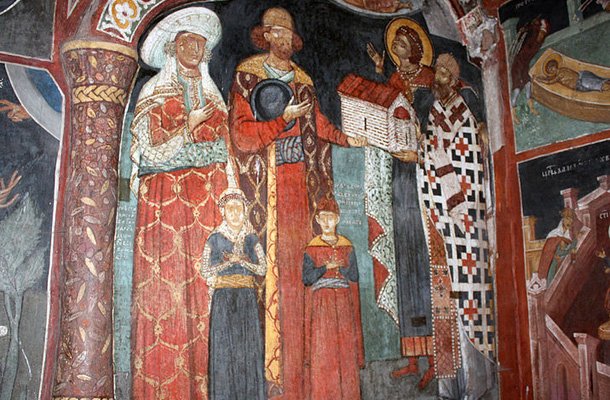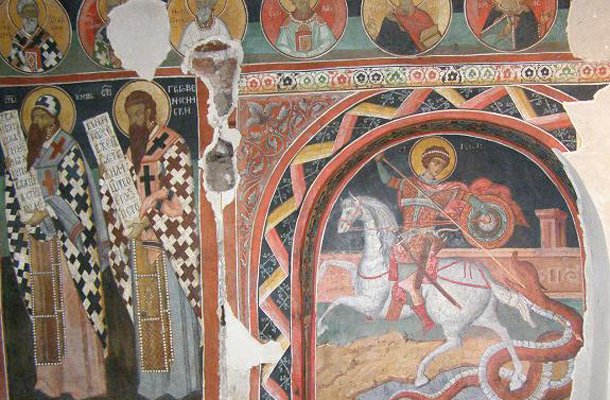St. George the Victory Bringer Monastery is 24 km to the northeast of Sofia, high above the suburb of Kremikovtsi in the southern slopes of the Balkan Range, amid magnificent natural scenery. During the Middle Ages the site was one of the fourteen monasteries known as the Sofia Holy Mountain. The legend has it that the monastery was built by one of the last Bulgarian tsars, Ivan Alexander, in the 14 c. during the reign of the Second Bulgarian Kingdom. It was reduced to rubble by the Ottoman invaders as they seized the local stronghold. In 1497 the monastery was rebuilt by boyar Radivoy from Sofia. This was the second rebuilt monastery from the Sofia Holy Mountain after the one in Dragalevbtsi. The restoration was supported by Sofia Bishop Ioan Kalevit who consecrated the monastery’s church that rose to replace the destroyed one honoring St. George Victory Bringer in 1493. Since then brisk spiritual life has been thriving at the monastery.
The oldest structure in the monastery compound is the St. George Church built of stone and bricks. Light penetrates inside it through three narrow windows. Undoubtedly, the frescoes in the church have very high artistic value, especially the mural of the church donors. An inscription on it reads that in 1493 the well-to-do local boyar Radivoy restored the church and sponsored its decoration. He did this to commemorate his children Todor and Dragana who died a year earlier most probably from plague that devastated the region of Sofia. So, in the portrait of the donor family the kids have been depicted with crossed hands, as if they are deceased. According to other legend the children contracted the deadly disease on the way back from the Holy Sepulcher in Jerusalem where the family had gone on a pilgrimage. During restoration works in 1987 four graves were excavated of children aged between 3 and 9. Most probably, two of them are the graves of Radivoy’s children. The donor family portrait includes the figure of the boyar’s wife Theodora, and also the figure of Sofia Bishop Kalevit.

For close to four centuries the Kremikovtsi Monastery was keeping the relics of St. George the New of Sofia who died for the Christian faith on 10 February 1515. An ancient legend has it that the relics were found by a shepherd in the ashes where George was put to fire and died. The shepherd saw a star shining above the ashes, took away the relics and kept them for thirty years. One night St. George came to his dream and instructed him to take the relics to the Monastery of Kremikovtsi. The imperishable bone coated in gold and silver was placed in a wooden chest back in 18 c. Later the holy relics were kept in a dedicated silver case that had a thin gilded plate with an opening that allowed seeing the bone inside. The relics of St. George the New of Sofia gave rise to the locals’ deep veneration for the monastery. They came over to the holy place to find a cure for ailments, and pilgrims flocked from far away too.
Centuries on, in 1952, when the communist regime was in full swing in Bulgaria, the nuns driven away from the Monastery of Kremikovtsi took the relics and moved them to the Monastery of Dragalevtsi where they are kept to date.
The Monastery of Kremikovtsi played an important role as a literary center of the region during the Bulgarian National Revival. It both produced and carried out an exchange of manuscripts. One major monument from that era is the celebrated Kremikovtsi Tetraevangelia, a valuable manuscript dated 1497. It is seen as a successor of the literary tradition established by Patriarch Euthimius of Tarnovo. Today the gospel is kept at the Museum of Ecclesiastical History and Archeology in Sofia. It is made up of 307 sheets filled with immaculate large writing and decorated with beautiful vignettes and capital letters. For a long time it was used as a gospel for service at the monastery. In 16 c. a silver casing lined with gold-leaf was made to hold the manuscript.
The library of the Monastery of Kremikovtsi keeps a gospel dated 1579 by priest Ioan Kratovski richly decorated with gold dye ornaments. One curious object from the monastery was an old stone candlestick from 15 c. shaped like a column. It was the work of master Voucho, most probably a relative of the boyar-benefactor of the site.
Similar to other such holy places, the Monastery of Kremikovtsi was committed to the national-liberation struggles of the Bulgarian people against the Ottoman rule. A commemorative plate at the front door recalls that in June 1876 following the crushing of the detachment led by Hristo Botev, one of the standard-bearers of the rebels Dimitar Stefanov the Cossack hid in one of the monastic cells. The Turks found out that a rebel was hiding in the monastery and demanded his handover. The then Father Superior Hadji Auxentius hid the rebel in a tree hollow in the woods. A few days later the Turkish search party found him and killed him. In 1912 a monument was built in the place where he died.
Since the liberation of Bulgaria from Turkish rule the Monastery of Kremikovtsi has operated almost without any interruption. In the past it was a male monastery. In 1879 a few nuns came over to it. They were refugees from Macedonia and contributed into the enlivenment and the popularity of the place. In 1901 the construction of a new large church started in the churchyard, Shroud of the Holy Virgin Mary consecrated in 1907. It is an impressive structure with beautiful wood-carving and a magnificent icon of the Holy Virgin.

Until 1947, 32 nuns inhabited the monastery. They were involved in farming and animal husbandry. In 1952-1953 a regiment invaded the monastery. There a bunker was built and the soldiers used the compound for accommodation. Part of the structure was burnt down, the dome of the new church pierced with bullets and the windows were broken. Many of the frescoes in the old church were covered with lime. The nuns had to leave and some moved to the Monastery of Dragalevtsi. The military remained at the Monastery of Kremikovtsi for 18 years. Later it was used to accommodate workers and pupils from crafts schools.
Around 1970 some of the nuns returned to Kremikovtsi and restored the monastery. Today many patriotic benefactors raise charities for the Monastery of Kremikovtsi. The restoration of the frescoes in the old church began in 1980 and went on until 2003 г. Today the church is not used for service but is open for visitors. It was declared monument of culture in 1969.
On 18 January 2010, the Feast of St. Anthony the Great, a new chapel was consecrated at the Monastery of Kremikovtsi dedicated to the saint.
The monastery is a popular place that attracts many visitors from the suburb of Kremikovtsi and from Sofia. The Feast of St. George the Victory Bringer, May 6, is celebrated as the Day of the Monastery. On that day major celebrations are held here, as well as on 15 August, the Assumption. The natural scenery of Kremikovtsi Monastery is very beautiful and quite popular for outings. The vista that opens up from the new church reveals almost the entire Sofia Valley.
Translated by Daniela Konstantinova